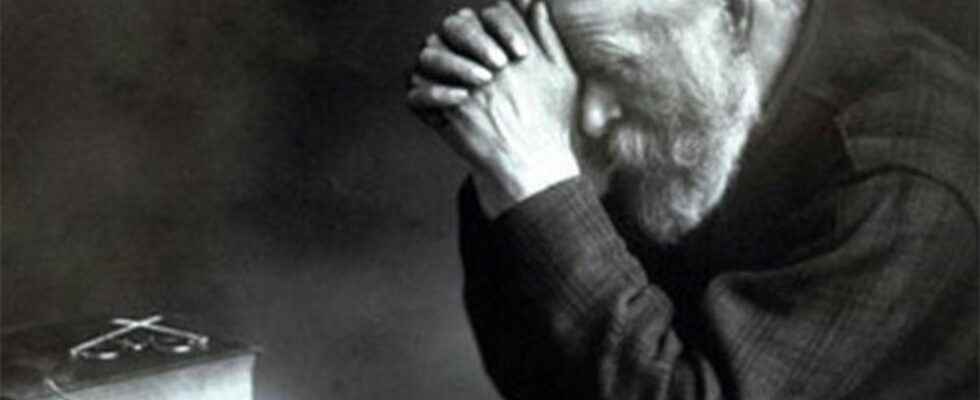
An iconic 20th-century painting of an old man praying over a simple meal in front of his Bible is framed by erroneous assumption. Much of what people have always thought is wrong.
First, the painting started as a photo taken in 1918 amid the First World War by Swedish-American Eric Enstrom in his studio in the tiny mining town of Bovey, Minn. The photographer was putting together a portfolio for an upcoming convention when a salesman peddling boot-scrappers knocked on his door.
As soon as Enstrom saw Charles Wilden, he knew he had to take the older man’s picture.
“There was something about the old gentleman’s face that immediately impressed me,” the photographer recalled. “I saw he had a kind face [and] there weren’t any harsh lines in it.
“I wanted to take a picture that would show people that, even though they had to do without many things because of the war, they still had much to be thankful for.”
So Enstrom posed Wilden at a small table with various props, including a bowl of broth with a loaf of bread, reading glasses and a large book that was actually a dictionary because no Bible was handy.
Then he had Wilden pretend to pray with folded hands at his brow, as if asking a blessing before a meal, which is why Enstrom called the photographer Grace.
As soon as the negative was developed, it was clear the photographer had something special. The picture was a big hit at the convention, and Enstrom started selling copies around Bovey.
In 1926, he paid Wilden $5 to waive his rights to the picture, then licensed it to a Lutheran publisher in 1930. In the 1940s, his daughter, Rhoda Nyberg, colored the photo by hand and added a streak of light to the scene.
That’s when the picture became wildly popular, showing up in homes, churches, restaurants and mission stations.
By then, Wilden had disappeared. Enstrom tried to find him in Grand Rapids, Mich., where the man had lived in a primitive sod house, but all he found were local stories of a hard-drinking no-account who just up and vanished.
So, the painting was really a photo; the Bible was actually a dictionary and the seemingly devout subject of the picture didn’t live a pious life. But does it matter?
When this debate played out on YouTube recently, opinion was divided. Some were soured by the true details. But others felt the most important factor is the meaning of the picture and its ability to inspire faith, gratitude and personal reflection.
It seems to me that if we insist art must strictly adhere to legalistic detail, and only involve artists and subjects with pristine lives, we’d have to renounce a great many religious masterpieces, let alone most of our favorite songs and movie performances. But there’s a wider issue.
As I wrote recently, the New Testament compares Christians to works of art who are made new and priceless by the love, mercy, and forgiveness of God.
“For we are God’s masterpiece, Paul writes. “He has created us anew in Christ Jesus, so we can do the good things He planned for us long ago.” (Ephesian 2:10)
But my life—and probably yours—can’t hold up to a scrutiny that demands perfection.
We continue to mess up, which is why we constantly need God’s grace. Though we have to avoid the deliberate hypocrisy Jesus condemns among those who don’t practice what they preach — but pretend otherwise — we must also recognize that not all sin and failure are hypocritical.
When we acknowledge early and often we’re flawed and sinful; when we try our best to live the way God wants; and when we rely on His power to restore and change us when we do fail, nobody gets to call us hypocritical.
A hypocrite is someone who pretends to be better than everybody else, and levels harsh judgment at others while doing things equally intentional and offensive. Sadly, there are some Christians like that.
But it’s blatantly unfair and unreasonable to dismiss someone’s entire faith any time they sin.
If someone took a snapshot of my life, it would be called Grace, too. It would never be called Perfection. I need God’s undeserved favour.
Because no matter how hard I try, there will always be lots in the picture that isn’t quite right. People may make wrong assumptions about what they’re seeing, whether good or bad. And I’ll never be the fully-formed role model God wants me to be. You, either.
But even with all our flaws, God can use us if we’ll trust Him and yield to His direction. He can display His loving mercy in our lives to inspire faith, thankfulness, and reflection among those who see it. And His Spirit can enhance the picture people see by coloring our lives with His love and Light.
It’s one thing to say grace, and quite another to live it.
Share your thoughts with Rick Gamble at [email protected] A former TV reporter and journalism prof, he pastors an independent, non-denominational church in Brantford called Followers of Christ (www.followers.ca).
